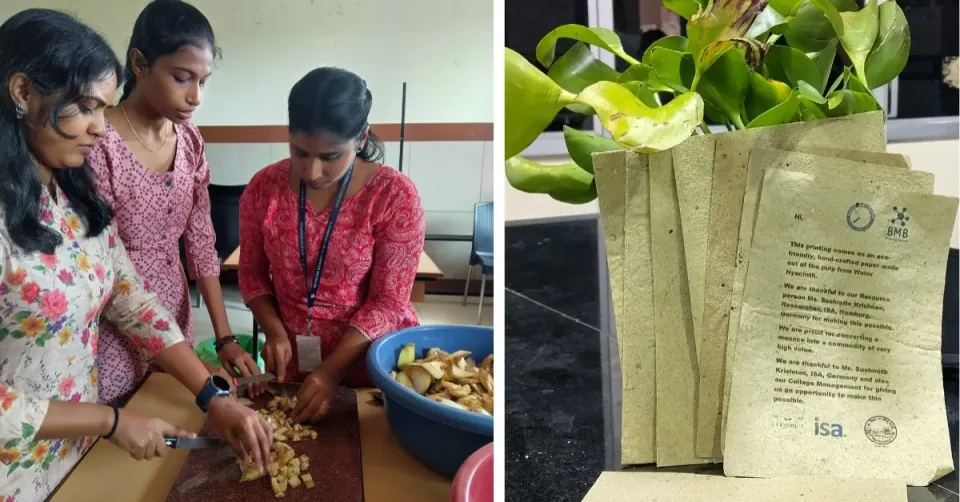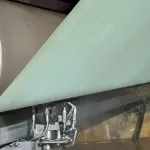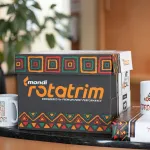What do you do with a weed that grows back in 14 days and kills everything in its path. In Trichy, 25-year-old ecologist Sushmita Krishnan found an answer — she turned it into handmade paper and trained 150 women to do the same.
On a sunny afternoon in Trichy, Tamil Nadu, a group of students gathers around a shallow water body, their eyes fixed on a thick green mat floating on the surface. At first glance, it looks serene — glossy leaves, purple flowers, and dragonflies weaving through the stalks. But for 25-year-old ecologist Sushmita Krishnan, this is not a picture of calm. It’s a warning sign.
“I often hear people say, ‘Oh, what a beautiful plant!’ But water hyacinth is invasive. It chokes lakes, kills biodiversity, and keeps coming back,” she explains. This tension between beauty and destruction is what drew Sushmita to the plant in the first place. Determined to find a sustainable solution, she began experimenting with its fibrous stems — and discovered that they could be transformed into strong, biodegradable, handmade paper.
What began as an academic curiosity has now grown into something far bigger. Sushmita isn’t just making paper — she’s building a grassroots model that combines science, sustainability, and community training to tackle one of India’s most stubborn aquatic weeds.
Seeing the problem beneath the surface :
Sushmita’s interest in ecology began early. Through her life sciences education, she found herself drawn to the complex relationships between species and ecosystems. But it was during her internship at the Indian Institute of Science in 2021 that something shifted.
“I was working on insect pests and the economic losses they caused. That’s when I first started looking closely at invasive species,” she recalls. One such species was water hyacinth. While some researchers praised its ability to purify water by absorbing heavy metals, others raised concerns about its impact on native biodiversity. The conflicting opinions intrigued her — and left her with more questions than answers.
“Water hyacinth has two faces, even in research,” she says. “Technologists see it as a boon because it phytoremediates water. But ecologists see it as a threat. It spreads fast and suffocates everything else.”
In places like Karnataka, it was even introduced deliberately, with the hope that it would help clean polluted water bodies. But its rapid multiplication soon made it unmanageable. Meanwhile, in states like Assam and Tamil Nadu, small communities had begun using water hyacinth to make crafts like baskets and bags. But these efforts, while creative, weren’t easy to scale. “It was time-consuming work, and people weren’t buying those products in large numbers,” Sushmita explains.
The plant that refuses to die :
It didn’t take long for Sushmita to realise that water hyacinth wasn’t just a local nuisance — it was a large-scale ecological crisis. What makes it so difficult to control is its extraordinary ability to multiply.
“One water hyacinth plant can produce around 3,000 seeds in its lifetime,” she explains. “And those seeds can stay dormant for up to 20 years if the conditions aren’t right. Once they find the right conditions, they grow back within 7 to 14 days.”
The result is a dense, fast-spreading carpet that clogs waterways, depletes oxygen, and threatens aquatic ecosystems. In Trichy alone, the plant covers nearly 21 km of water bodies. Before the monsoon each year, the government attempts to clear some of this biomass — but the efforts barely make a dent.
“They manage to clear just 2 km before the rains begin,” Sushmita says. “And even that takes a bulldozer, several days, and about 20 lorry loads of hyacinth. It’s expensive, time-consuming, and all of it ends up in landfills.”
A breakthrough in Germany :
In 2024, Sushmita’s search for a better solution led her far from Tamil Nadu — to the labs of the University of Hamburg in Germany. She had been selected for the prestigious International Sustainability Academy (ISA) fellowship, which supports young changemakers tackling global environmental challenges.
Out of hundreds of applicants, she was one of only 12 fellows chosen worldwide — and the only one from India. “At the University of Hamburg, I worked in a wood chemistry lab with Professor Bodosake, who specialises in pulp-making,” she recalls. “That’s where we began experimenting with water hyacinth as a paper raw material.”
The results surprised even the researchers. “Normally, making paper from wood pulp uses around 60% soda. But we found that with water hyacinth, you only need about 6%. And the quality of the pulp was excellent — strong, clean, and easy to work with.”
The breakthrough proved what she had long suspected — water hyacinth didn’t need to be a burden. With the right technique, it could become a sustainable, scalable material.
Back home, but not yet on board :
Energised by her success in Germany, Sushmita returned to India with a clear goal — to scale up the process and introduce water hyacinth paper into mainstream production.
“I began reaching out to paper industries,” she says. “This could be a new income source for communities that pulp water hyacinth and supply it to factories.” But she quickly ran into a familiar roadblock: hesitation. Despite her data and lab results, paper manufacturers were reluctant to test alternative raw materials. Adopting a new process meant investment, trial runs, and regulatory approvals — and many didn’t want to take the risk.
“Even with proper patents and publications, the industry would take at least three years to switch,” she explains. “But in three years, a lot can happen at the grassroots level.” That realisation shifted her focus. If industries weren’t ready to move, she would start with the people.
Taking the method to the people :
Sushmita knew the method would only matter if people could use it. So she began conducting hands-on workshops, sharing her process with students, educators, and women from local communities. “Now I’ve started training people to make paper from water hyacinth. Many colleges are interested in adapting it for their own use,” she says.
At National College, Trichy, she ran a two-day workshop that combined science with skill-building. “We had a theory session on the first day about water hyacinths, but the second day we had hands-on experience in creating the papers from scratch,” shares Ishika, a student who attended.
Those students are using their own handmade paper for greeting cards and college events. Beyond campuses, she has also trained over 150 women — including a group of middle-aged women in Velachery, Chennai, supported by the Ministry of Environment. “We had two workshops for the Ministry, three for colleges, and a few more are lined up,” she adds.
For Sushmita, the goal was not just awareness, but adoption. The more people who learned the method, the more likely it was to catch on — especially in places overrun by hyacinth.
From pond to page : The paper-making process :
The process of turning water hyacinth into paper is surprisingly simple — and designed to be both cost-effective and environmentally conscious.
It begins with harvesting the plant’s stems, which are then sun-dried and boiled in an alkaline solution to break down the fibres. This softened pulp is beaten and mixed with water and a natural plant-based binder to create a slurry. The mixture is poured onto mesh frames, where the water drains out and the thin layer of pulp is left to dry under the sun.
Unlike many other small-scale paper makers, Sushmita does not rely on newspaper pulp to hold the paper together. Nor does she bleach it to make it look “cleaner”. “I use only natural binders, and the paper retains its natural greenish tint. I believe the quality of paper is defined by how easy it is to write on — not just how white it looks,” she says.
The entire process is quick and low-cost. “With 1 kg of wet water hyacinth, you can make 30 A4 sheets,” she estimates. “From harvesting to making the pulp, it takes about 25 minutes. The drying takes another 45. With practice, you can do it even faster — maybe in 15 minutes. And the cost per sheet shouldn’t be more than Rs 2.”
Sustainable change happens from the bottom up :
While her workshops have sparked interest and early adoption, Sushmita is clear-eyed about the scale of the challenge. “Just by making handmade paper, we can’t restore an ecosystem,” she says. “Water hyacinth grows at such a rapid pace — one hectare can produce up to 700 tonnes of it in a year. That’s something only large industries can tackle effectively.”
Still, she believes community-led solutions like hers can nudge the system forward. By building awareness, demonstrating the potential, and training people directly affected by the plant, she hopes to create enough momentum for wider institutional adoption.
Her long-term plans are rooted in research and impact. She now aims to pursue a PhD that focuses on water hyacinth’s social, economic, and environmental dimensions. She’s also experimenting with new pulp-based alternatives — including biodegradable sanitary pads, in collaboration with a Nepal-based NGO.
“At a personal level, I’m trying to develop paper plates and cups as well, using thermal press technology,” she shares. These products could provide additional income opportunities for communities while replacing single-use plastic and foam. With each new idea, Sushmita stays grounded in the same belief that sparked it all — that sustainable change grows from the bottom up.
Turning nuisance into knowledge :
For decades, water hyacinth has been treated as waste — something to remove, to ignore, or to battle. But Sushmita Krishnan sees it differently. To her, it’s a chance to rethink how we solve ecological problems: not by erasing what’s difficult, but by understanding it, working with it, and turning it into something useful.
Through workshops, research, and community-led training, she has offered people not just a skill, but a shift in perspective. She’s not selling the paper herself. She’s sharing the method, empowering others to carry it forward in ways that make sense for them — in classrooms, kitchens, and craft groups across Tamil Nadu.
It’s still early. There’s more to learn, more to build, and more hands needed in the effort. But the impact is already visible — in the sheets made from lake weeds, in the women who now know how to make them, and in the idea that something so destructive can hold the potential to heal.
News Courtesy : The Better India




